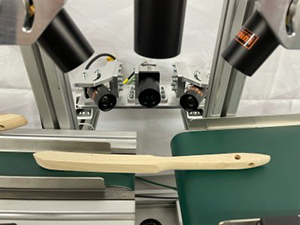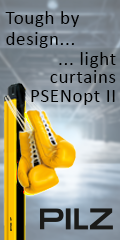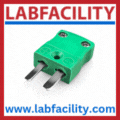
Posted to News on 16th Dec 2021, 00:00
Fully automatic inspection of wood parts
Whether classic all-purpose brushes or brushes for special applications, German company Lessmann has virtually all of them in its range. Regardless of shape, they all have one thing in common: the wooden bodies are made exclusively from untreated red beech. Depending on the model, they also have two hanging holes at the end of the handle.

Production is fully automatic and highly rational. In order to ensure the excellent quality of the hand brush woods, Lessmann has been relying on classic image processing for many years. But now the company has implemented an image processing system from the Bavarian system house Simon IBV that uses robust IDS industrial cameras and SIMAVIS H image processing software to detect even barely perceptible tolerance deviations particularly reliably.
The brush woods, which are milled fully automatically at a production rate of 1500 pieces per hour, are removed from the milling machine by a timed circulating chain with quiver-shaped receptacles and pushed onto a longitudinal conveyor belt. A multi-camera system is installed on the conveyor belt, which checks the 2- to 6-row hand-brushed timbers for defects such as cracks, splintering and size.
“The testing task is particularly demanding because the untreated copper beech varies greatly in its colour and grain. For example, cracks cannot always be clearly distinguished from dark grains,” explains Daniel Simon, authorised signatory at Simon IBV.
But the choice of wood type is for good reasons: on the one hand, red beech is recommended for the production of hand brushes due to its excellent properties, such as a special degree of hardness. On the other hand, sustainability plays a major role. Lessmann can source the brush wood from the surrounding area and thus both support regional forestry and avoid transport routes.
While the timbers pass through production on a conveyor belt, a total of four IDS cameras of the type GigE uEye FA are triggered by a so-called incremental encoder. This sensor reacts to the belt position so that any change in position of the brush body is detected by the belt movement. The image capture is offset by 2.5 mm per camera, so each camera takes a new image every 10 mm. The captured images are discarded until the first camera detects that there is a wooden body in the field of view. From this point on, the other three cameras are activated and up to 35 pictures are taken per camera.
The images captured by the IDS cameras are pre-processed and composited simultaneously with the image capture. Thus, during the time of evaluation, both the image acquisition and the pre-processing of the next brush can take place simultaneously. The individual images from the four offset cameras are cropped, scaled and merged into one overall image by the software. The brush bodies are evaluated with differently weighted criteria for each camera. The weighting is done via the test sequence of the evaluation criteria. In a first step, rough geometric factors such as length, width, height, symmetry and shape deviations are evaluated.
“Through the control, automatic further processing is possible. With the new imaging solution, wood defects can now be detected more reliably. The proportion of defective wood bodies classified as good has fallen from around 2 per cent to less than 1 per cent,” explains managing director Jürgen Lessmann.
The subsequent filling of the brush bodies with wire is already fully automatic, and the packaging of the finished hand brushes can be carried out in future with the help of robotics. Due to the improved control of the wooden bodies, the previously necessary manual quality control of the finished hand brush can be omitted. Before packing, which is carried out by a SCARA robot, only a brief visual inspection is necessary. This relieves the machine personnel and increases productivity.
In this exemplary application, the use of artificial intelligence also offers further potential in the future. “AI will probably further improve the inspection result, which will allow further automation of production, as manual inspection operations can be eliminated,” Jürgen Lessmann predicts.
IDS Imaging Development Systems Ltd
Cheyenne House
West Street
GU9 7EQ
UNITED KINGDOM
+44 (0) 1252 916656





